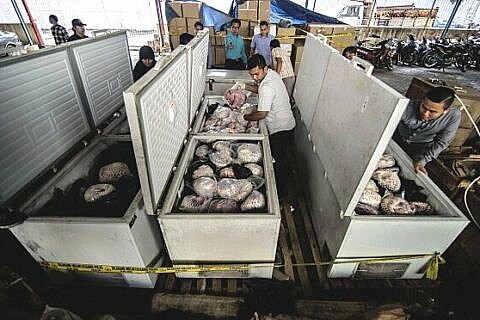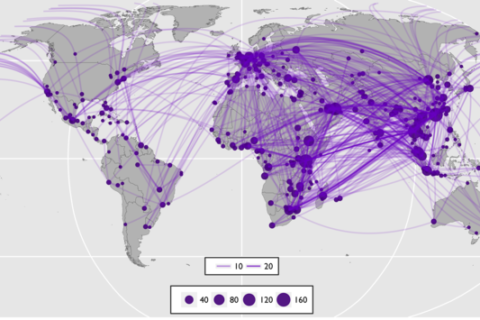Assets in Flight
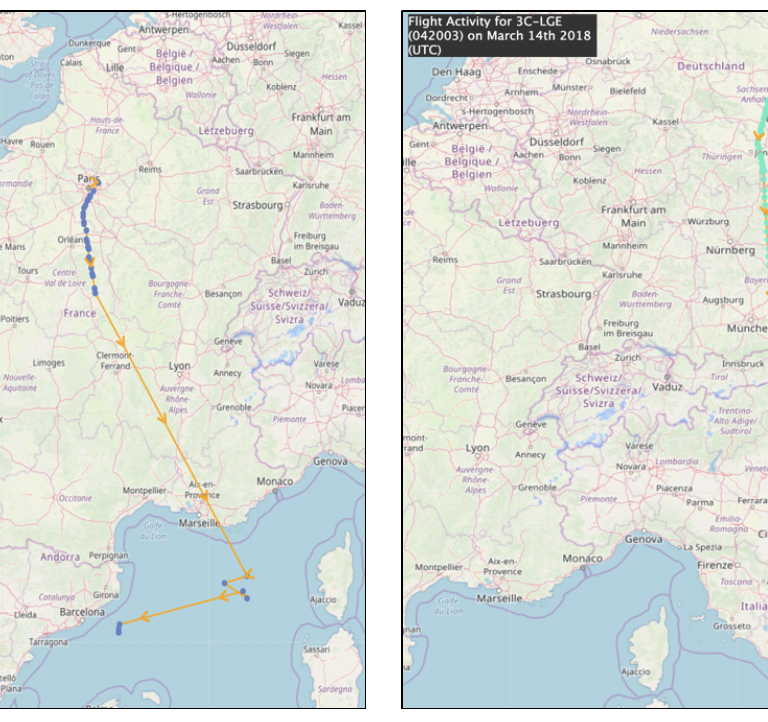
Five of the top ten longest serving heads of states govern African countries, all with tenures in office of over 20 years. Four of the five – Paul Biya (Cameroon), Teodoro Obiang’s Nguema Mbasogo (Equatorial Guinea), Dennis Sassou Nguesso (Republic of Congo) and Yoweri Museveni (Uganda) are over 70 years old. And until recently this cadre of rulers also included Omar al Bashir (Sudan) whose ouster on April 11, 2019 closely followed that of Abdelaziz Bouteflika, the 82-year-old former President of Algeria whose 20-year rule ended in forced resignation on April 2, 2019.
These heads of state, both current and former, reportedly preside over impressive personal fortunes and commercial empires that are shrouded in secrecy and often hidden from public scrutiny. In 2017, French authorities successfully prosecuted and convicted Equatorial Guinea’s Vice President Teodoro Nguema Obiang Mangue (the son of the President) for illegally investing millions in embezzled funds through French real estate, luxury vehicles, and other assets. The investigation led to the seizure of a Parisian mansion worth $120 million and just one of Teodoro’s sprawling assets, which in 2011 included $70 million in US-based luxury assets, two Malibu mansions, and a $30 million Gulfstream private jet.

The identification of the $30 million aircraft linked to Teodoro Obiang piqued the interest of C4ADS analysts, who in the past several months have investigated foreign air travel as an indicator of where kleptocrats store their wealth.
Tracing Equatorial Guinea’s Executive Fleet #
Back in 2011, the US Department of Justice (DOJ) found that Teodoro Obiang purchased a Gulfstream G-V aircraft (Cayman Islands Registration Number: VP-CES) through a Cayman Island-based company, Ebony Shine International Ltd for an estimated $33.8 million. The DOJ filed an asset forfeiture suit against the aircraft claiming that the purchase was financed by embezzled funds. The suit was eventually settled in 2014, and the aircraft barred from entering the United States while owned by Equatorial Guinean officials, their family members, and/or affiliated companies or businesses.

But despite the use of off-shore shell companies to obscure aircraft ownership, aircraft identification is made possible by the existence of several universal regulations adopted by most UN Member States. As a result of the 1944 Chicago Convention on International Civil Aviation, which established the International Civil Aviation Organization (ICAO), all civilian aircraft must be registered with a National Aviation Authority (NAA) which issues alpha-numeric aircraft registration numbers to all civilian aircraft before they can legally operate internationally. These alpha-numeric registration numbers (commonly known as tail code numbers) are often the most visible identifying feature of an aircraft (as displayed below) and have a discernible naming convention that helps identify the country of registry.

Each aircraft’s tail code number begins with a two-character prefix i.e “YA-XXX” that identifies the aircraft’s country of registration (also known as an aircraft nationality mark or emblem). Aircraft registered in the Equatorial Guinea begin with a “3C-” prefix, which indicates that all aircraft that bear that marking are registered with the country’s civil aviation authority. But in Equatorial Guinea, like many other African countries, the domestic civil aviation authority does not publicly disclose its domestically-registered private aircraft, thus limiting public visibility on the number of private or corporate-owned aircraft.
Overcoming the Paucity of Publicly-Available Domestic Aircraft Registers #
In countries where official, publicly available aircraft registers are unavailable, aviation enthusiasts often provide a lifeline. Over the past several decades, these communities of enthusiasts have compiled hundreds of non-official aircraft registers that provide a helpful guide into current and historic aircraft registration records in some of the most data scarce environments across the globe. Some of these enthusiast-compiled registers include but are not limited to: the OpenSky Network, OpenFlights.org, Antonakis Spotters, Torben Koed, Brugier.com, and the LAAS International Corporate Aircraft register.
Using the aforementioned LAAS corporate aircraft register, we uncovered five executive/business-class aircraft, including two Dassault Falcons, a Lockheed Jetstar and a single Gulfstream V that operate under the “3C-”country designation, suggesting local registration in Equatorial Guinea.
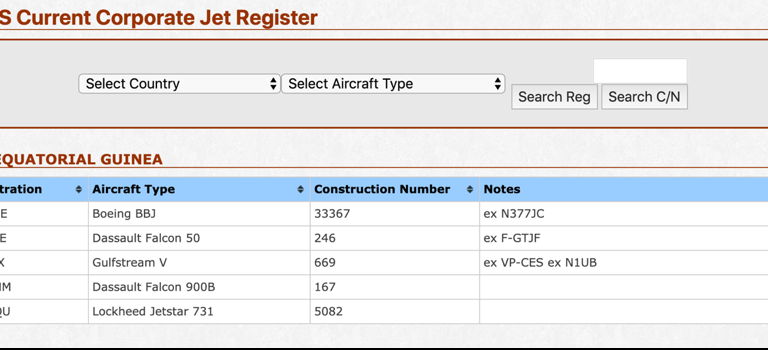
However, based on the available imagery, this executive fleet differed quite starkly from Equatorial Guinea’s commercial airliners, a finding that suggests that these aircraft are likely operated by private parties or by the Equatorial Guinea government. Open-source images of the aircraft fleet also revealed a paint and flag pattern that closely resembles the country’s flag and coat of arms.
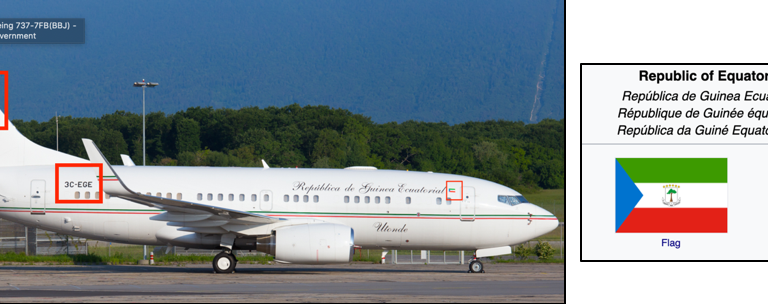
The Equatorial Guinea Executive Fleet In Flight #
Having identified the five non-commercial aircraft associated with the Equatorial Guinea government and/or some of the government’s private associates, we used open-source flight tracking data to identify and track their transit activities abroad. The available data revealed that at least one of the planes in this fleet – a Dassault Falcon 50 (Registration Number: 3C-LGE) – had made at least 17 trips in and around Berlin and Paris between February 25, 2018 and May 26, 2019.
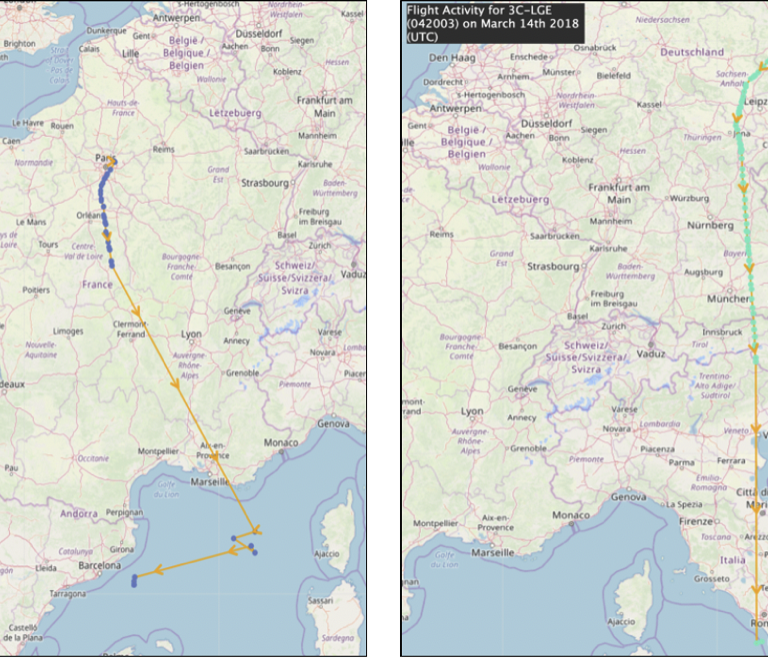
Between November 2018 and April 2019, we identified 10 trips in and around Paris and Geneva taken by a Dassault Falcon 900B (3C-ONM) aircraft associated with Teodoro Obiang. This data was captured by ADS-B Exchange, an open-source flight tracking tool that is part of collaborative effort between C4ADS and ADS-B Exchange designed to improve the investigative use of flight data in open source research.
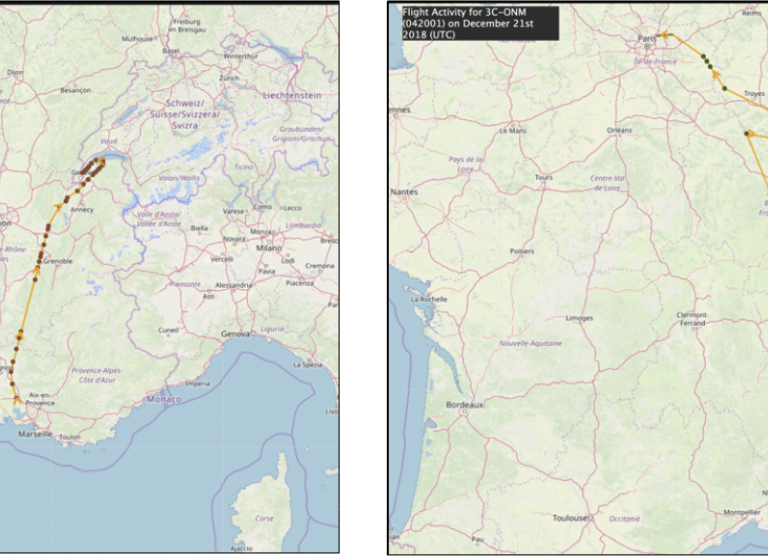
Closer investigation into the aircraft’s arrivals in and around Geneva airport indicated that the majority of these arrivals occurred in the evening and were followed by next-day morning departures between May and December, 2018 according to the Geneva Airport Movement Enquiries database, a collection of landing and take-off flight data compiled by Geneva-area aircraft spotters. We also found over 200 landing and take-off events at Geneva airport between June 15, 2008 and May 29, 2019. These early findings indicate that the aircraft remains in operation and frequents Geneva airport on a fairly regular schedule.
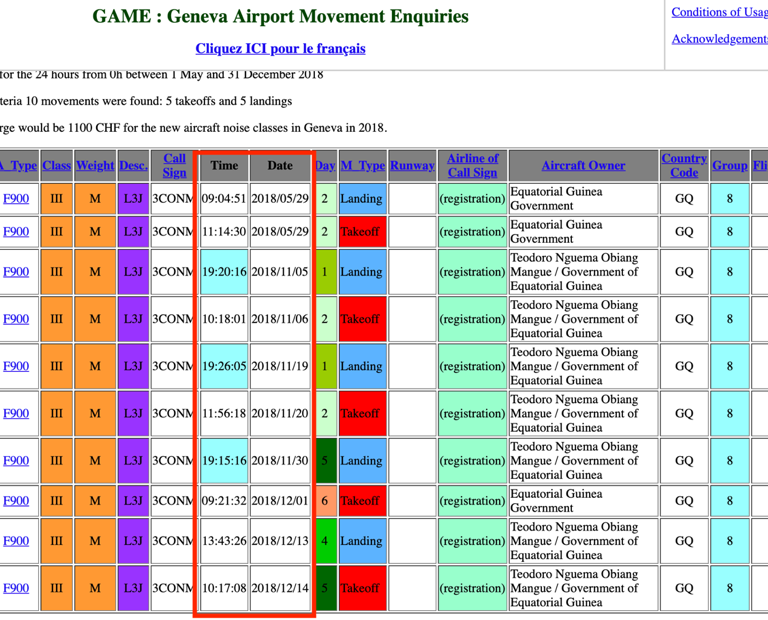
Pattern of Life #
Based on this initial research, we focused on tracing the globe-trotting activities of corrupt world leaders, particularly when that travel involves high risk banking jurisdictions, tax havens, and other luxury locales around the world. We have so far found that the combination of open-source aircraft registries and flight data provides excellent insights into the often-hidden activities of unscrupulous public officials.
Further research also revealed that another aircraft within the fleet – a Gulfstream V (Registration Number: 3C-LLX) had made at least five trips into Brazil throughout 2018. Several of these trips occurred around the September 17, 2018 detention of Teodoro Obiang’s entourage in Sao Paolo where Brazilian authorities seized $16 million in cash and luxury watches. Coverage of the incident indicated that Obiang’s 11-person delegation arrived on a government plane and were headed for Singapore after the stop in Brazil. We later found that the same Gulfstream V private aircraft was spotted flying east of Singapore on November 6, 2018 (pictured below) several days after the incident.
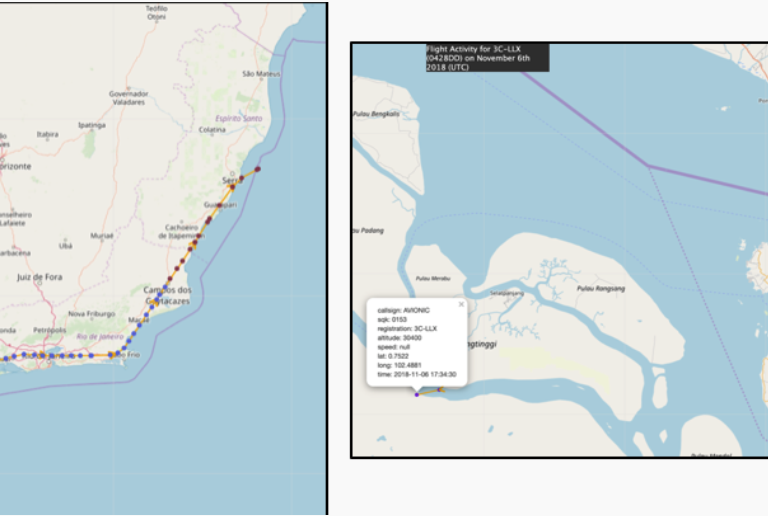
These preliminary findings indicate that despite the lack of official public registries in countries like Equatorial Guinea, the combination of unofficial flight registries and public-sourced air transit data does reveal insights into closely held travel activities of public officials like Teodoro Obiang.
Stitched together, these data points reveal the great untapped potential that open flight tracking offers to open-source researchers and investigators, and broadens the investigative toolkit available to global transparency and accountability researchers, advocates, and enforcement agents. Over the next several months, C4ADS intends to publish a series of investigations that build upon the insights gleaned from this case in order to highlight investigative applications of publicly accessible flight data in open-source research.

